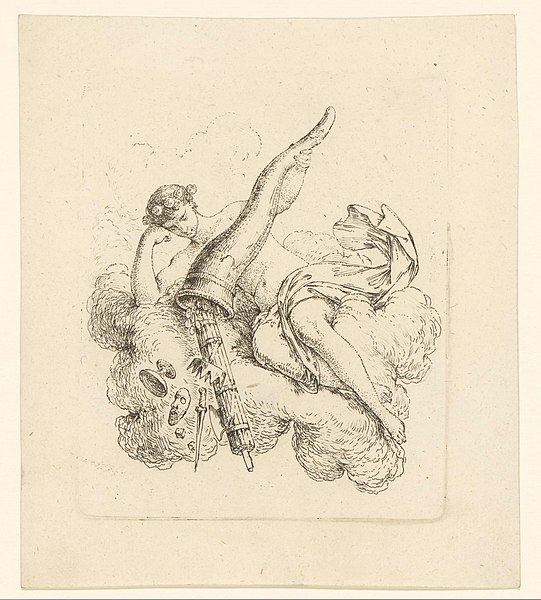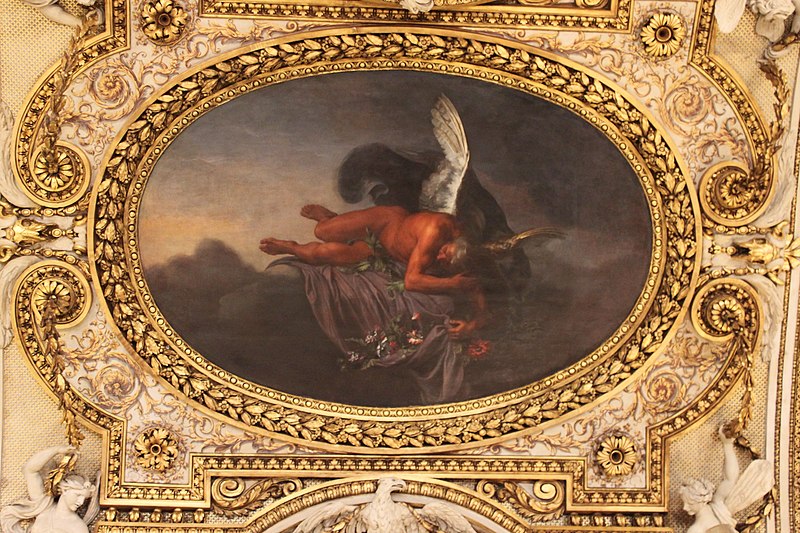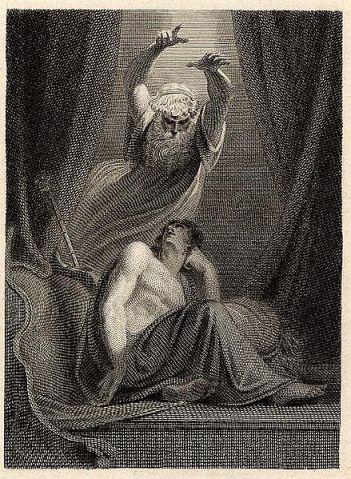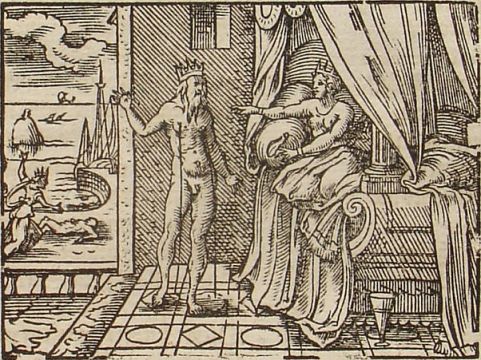In the heart of ancient Greek mythology, a realm exists that bridges the conscious with the unconscious, the seen with the unseen. Among the deities governing this elusive domain are the Oneiroi, the gods of dreams. These ethereal beings play a crucial role in connecting mortals with divine messages through the veil of sleep. While they might be overshadowed by more prominent gods, they are the unsung navigators of nightly visions.
They are the children of Nyx, the goddess of the night, embodying the bridge between the mortal realm and the divine messages conveyed through dreams. Our journey into the enigmatic world of the Oneiroi unveils a facet of Greek mythology that resonates with the universal human experience of dreaming.
Oneiroi Key Facts
| Parents | Nyx |
| Partners | None |
| Siblings | Thanatos, Hypnos, Oizys |
| Offspring | None |
| Other names | Dream Spirits |
| Roman name | Somnia |
| The God of | Dreams |
| Symbols | Poppy, Wings |
Name and Etymology
The name ‘Oneiroi’ is derived from the ancient Greek word ‘ὄνειρος’ (oneiros), which translates to ‘dream’ or ‘night vision’. This etymology reflects the essential nature of these deities as the bearers of dreams, the messengers of the night. The Roman counterpart of the Oneiroi is known as the Somnia, a name that carries a similar dreamy resonance. The epithets and other names associated with the Oneiroi often emphasize their ethereal, elusive nature and their role as the conveyors of divine messages through the dream realm.

In ancient texts, the Oneiroi are often referred to collectively, their individual identities merging into the singular purpose of governing the dream world. This collective identity further emphasizes their role as a bridge between the mortal and divine, the known and the unknown. The Roman name ‘Somnia’ too, echoes a collective essence, portraying the shared responsibility of governing dreams among these deities.
Though often referred to collectively, a few individual Oneiroi are named in ancient texts. These include:
- Morpheus: Known as the god of dreams, Morpheus is the most recognized among the Oneiroi. He is often depicted as having the ability to take on any human form and appear in dreams.
- Phobetor: Also known as Icelos, Phobetor is the god of nightmares, often manifesting as fearsome beasts in the dreams of mortals.
- Phantasos: Phantasos is known for creating surreal and bizarre landscapes in dreams, often crafting inanimate objects into the dream realm.
- Icelos: Another name for Phobetor, emphasizing his ability to create terrifying imagery within dreams.
These individual identities within the collective of the Oneiroi underscore the diverse nature of the dream realm, each god representing different facets of the dreaming experience.
Oneiroi Origins
The Oneiroi are born of Nyx, the primordial goddess of the night, a deity often associated with mysteries and the unseen. Their lineage places them amidst a family of deities governing various aspects of death, sleep, and dreams, with siblings like Oizys (Misery), and Thanatos (Death), and Hypnos (Sleep) sharing the dark, quiet realm of the night. This immediate family reflects a thematic coherence in the ancient Greek understanding of the unseen realms that touch human existence.
There isn’t much detailed insight about the birth or childhood of the Oneiroi, as they are often perceived more as personifications rather than anthropomorphic gods with human-like narratives. Their existence is intertwined with the natural phenomenon of dreaming, a universal experience shared by all of humanity. The Oneiroi, as Daemones (Spirits) of dreams, embody the ethereal connection between the mortal realm and the divine messages conveyed through the veil of sleep.
Oneiroi Relationships
The narrative of the Oneiroi doesn’t delve into romantic entanglements or relationships as seen with many other Greek gods and goddesses. Their ethereal nature and collective identity focus more on their divine function rather than personal interactions or relationships.
Similarly, there isn’t a narrative concerning offspring of the Oneiroi. Their portrayal centers around their function as dream navigators rather than familial relations or progeny.
Depiction And Characteristics
The Oneiroi are often depicted with wings, symbolizing their swift and silent entry into the mortal realm as bringers of dreams. Their ethereal appearance is a testament to their elusive nature, often slipping through the fingers of human understanding yet leaving a profound impact. The symbol of poppy, associated with sleep and dreams, is often linked with the Oneiroi, further emphasizing their dominion over the dream realm.

Their portrayal in ancient art and texts often carries a surreal, ethereal quality, reflecting the transient, elusive nature of dreams. The wings of the Oneiroi symbolize the freedom and boundless nature of the dream realm, where the laws of the physical world give way to the boundless landscapes of the unconscious.
Oneiroi Personality
The personality of the Oneiroi is as elusive as the dreams they govern. They are often perceived as neutral entities, neither benevolent or malevolent, simply performing their divine duty of conveying dreams. Their actions within myths reflect a detached, almost mechanical adherence to their role, devoid of personal desires or emotions.
The perception of the Oneiroi by the ancient Greeks mirrors the universal human experience of dreams as mysterious, unpredictable, and often beyond mortal control. The Oneiroi, as the personification of dreams, embody this enigmatic, elusive aspect of human existence, navigating the murky waters of the unconscious with a silent, unseen presence.
Oneiroi Powers
The primary power of the Oneiroi lies in their dominion over dreams. They have the ability to shape, deliver, and govern the content of dreams, acting as the conduit between the divine realm and the mortal mind. Through dreams, they convey messages, prophecies, and insights, often providing a glimpse into the future or a deeper understanding of present circumstances.
Their power extends to the ability to move effortlessly between the mortal realm and the divine, transcending the boundaries that separate the seen from the unseen. This ability underscores the ancient Greek understanding of dreams as a bridge to the divine, a realm where the mortal mind could touch the cosmos and glean insights beyond the grasp of waking consciousness.
Oneiroi Symbols
Common symbols associated with the Oneiroi are wings and poppies. The wings represent their swift and silent movement through the night, delivering dreams to mortals. Poppies, on the other hand, are a symbol of sleep and dreams, often depicted alongside the Oneiroi and their sibling Hypnos (Sleep).
The association of poppies with the Oneiroi reflects the ancient understanding of the intertwined nature of sleep and dreams. The poppy, with its soporific qualities, symbolizes the gateway to the dream realm, a realm governed by the Oneiroi.
Oneiroi Roles And Responsibilities
The main role of the Oneiroi is to govern the realm of dreams, acting as the bridge between the mortal and the divine. They deliver messages, prophecies, and insights through dreams, providing a conduit for divine communication. Their responsibility extends to ensuring the smooth transition between the waking and dreaming states, maintaining the delicate balance between the conscious and the unconscious.
The Oneiroi also play a role in connecting mortals with the broader cosmos through dreams. They provide a glimpse into the unseen, a touch of the divine within the mundane realm of human existence. Their governance over dreams underscores the ancient Greek belief in the interconnectedness of all existence, the seamless web that binds the mortal with the divine, the seen with the unseen.
The responsibilities of the Oneiroi reflect a profound understanding of the human psyche within Greek mythology. They embody the ancient belief in the power of dreams to provide insight, guidance, and connection to the divine, a belief that resonates with the universal human experience of dreaming.
Myths about Oneiroi
The myths surrounding the Oneiroi often revolve around their role as dream deliverers, acting as the conduit for divine messages. These narratives offer a glimpse into the ancient Greek understanding of dreams as a medium of divine communication.
The Dream of Agamemnon
In Homer’s Iliad, the Oneiroi play a crucial role in conveying a deceptive dream to Agamemnon, the king of Mycenae. Zeus sends one of the Oneiroi to deliver a dream to Agamemnon, urging him to attack Troy with the promise of victory. This dream significantly influences Agamemnon’s decision, setting the stage for the unfolding drama of the Trojan War. The narrative underscores the ancient Greek understanding of dreams as a medium of divine communication, with the Oneiroi acting as the messengers.

The deceptive nature of the dream also reflects the unpredictable, elusive nature of the dream realm. Here, truth and illusion often intertwine, leaving mortals to navigate the murky waters of the unconscious. The impact of this dream on the course of the Trojan War highlights the profound influence of the Oneiroi on human destiny. Through this dream, the Oneiroi not only convey a divine message but also set in motion a chain of events that would shape the fate of heroes and kingdoms.
The Dream of Ceyx
In another well-known myth from Ovid’s Metamorphoses, the Oneiroi, specifically Morpheus, delivers a message to Alcyone about the fate of her husband, Ceyx. After a devastating storm at sea, Ceyx perishes, and Morpheus takes on the form of Ceyx to appear in Alcyone’s dream. He delivers the sad news of Ceyx’s demise, allowing her to mourn and eventually find closure.

This myth show the compassionate aspect of the Oneiroi’s role. Morpheus delivers a message that is painful, however it provides Alcyone with the truth and the ability to move forward. The narrative also highlights the Oneiroi’s power to take on any form. An example of their boundless, transformative nature within the dream realm.
Oneiroi In Ancient Greek Religion
There aren’t specific temples or sites dedicated solely to the Oneiroi. This is likely because their worship was intertwined with that of other deities associated with sleep, death, and the night. However, the ancient Greeks recognized the significance of dreams and the divine messages they often carried. Indeed, paying homage to the Oneiroi within the broader context of their religious practices.
Reverence for the Oneiroi reflects their understanding of the interconnectedness of the seen and unseen, the mortal and the divine. Though not as prominently worshiped as other gods, the Oneiroi held a significant place within the ancient Greek religious landscape. There they embodied the mystical, elusive realm of dreams that touched the lives of mortals in profound, often life-altering ways.
Mentions in Ancient Texts
Various ancient Greek texts mention the Oneiroi, highlighting their significance within the mythological and religious landscape. These mentions offer a glimpse into how ancient Greeks understood the dream realm and its broader significance.
Homer’s Iliad
In the Iliad, penned around the 8th century BCE by Homer, the Oneiroi play a pivotal role. They convey a deceptive dream to Agamemnon, setting the stage for the unfolding drama of the Trojan War. Renowned as one of the greatest ancient Greek epic poets, Homer also authored the Odyssey. His works significantly shaped the Western literary tradition. A verse from the Iliad vividly captures the Oneiroi’s role:
“Then went the ambrosial Night to the ships of the Achaians, to bear a message to Neleus’ son [Nestor], and in her going she took the shape of the son of Neleus, who was king with the highest authority of the Myrmidones by reason of his age.” – Iliad, Book 2
Hesiod’s Theogony
Hesiod’s Theogony, written around the 7th century BC, mentions the Oneiroi as children of Nyx, the goddess of the night. Hesiod, a contemporary of Homer, stands as a seminal figure in ancient Greek literature. His works delve into mythology and ancient Greek cosmogony. In Theogony, he places the Oneiroi within a family of deities associated with death, sleep, and dreams. In so doing, underscoring the thematic coherence within Greek mythology concerning unseen realms.
Ovid’s Metamorphoses
Ovid’s Metamorphoses, crafted in 8 CE, explores the theme of transformation across a wide range of myths. It includes tales of the Oneiroi’s Roman counterparts, the Somnia. Ovid, known for his immense influence on literature, delves into the realm of dreams through the lens of Roman mythology.
He provides a nuanced perspective on the Oneiroi’s role as dream navigators. In Metamorphoses, Ovid elaborates on the character of Morpheus, one of the Oneiroi,. Moreover, he describes his ability to mimic any human form in dreams. This narrative emphasizes the boundless, transformative nature of the dream realm.
Frequently Asked Questions
The Oneiroi represent the realm of dreams in Greek mythology, acting as the bridge between the mortal and the divine. The ancient Greeks believed that they were delivering messages, prophecies, and insights through dreams.
The Oneiroi are the children of Nyx, the primordial goddess of the night. Placing them within a family of deities associated with death, sleep, and dreams.
The Oneiroi are often depicted with wings, symbolizing their swift and silent movement through the night as bringers of dreams. They are also associated with the symbol of poppy, representing sleep and dreams.
The Roman counterpart of the Oneiroi is known as the Somnia. This is reflecting a continuity in the understanding of dreams as a means of divine communication across cultures.
The Oneiroi govern the realm of dreams, delivering divine messages, prophecies, and insights to mortals through dreams. That way theyare acting as the conduit between the mortal realm and the divine.
There aren’t specific temples dedicated solely to the Oneiroi. However, their reverence was often intertwined with the worship of other deities associated with sleep, death, and the night.
Featured Image Credit: Rijksmuseum, CC0 1.0, via Wikimedia Commons
